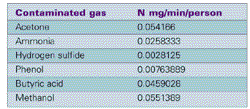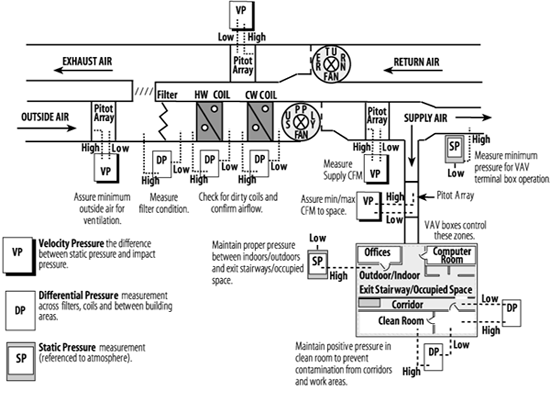
“The oxygen consumption rate is 0.36 l/min (0.013 cfm) when the activity level is 1.2 met (met = level of body activity such as filing/seated). For ventilation at a rate of 15 cfm and an activity of 1.2 met units, the room oxygen level will be reduced from an outdoor concentration to 20.9%. Thus, the oxygen content of the room is reduced from 21.0% to 20.9%, a change of only 0.5%. The carbon dioxide is raised from the background of 0.03% (300 ppm) to 0.1% (1,000 ppm), a change of 230%. Thus dilution of carbon dioxide is clearly more significant than replacing oxygen.”
This explanation indicates that the oxygen supply is not the primary reason that buildings require ventilation. The odors (contaminants, see Table 1) produced by people, and gases (odors) from furnishings, office, and manufacturing equipment are the primary reason buildings require ventilation.
Measuring each of these odors would require different instruments. Since carbon dioxide (CO2) is discharged by the occupants and present in the atmosphere, it is used as a reference for measuring odors in a building.
We cannot assume that outdoor air is free from contaminants. Fumes can enter into the ventilation air intake grille from outside and be distributed through the building.
Delivering the right amount of outdoor fresh air to dilute odors, and controlling the proper exhaust, is critical to air quality.
In most instances, ventilation is not delivered directly into each room. Most commercial building ventilation systems are designed with large ducts that branch off to smaller ducts with vav boxes, which may contain the cooling and heating elements, and then into the space requiring the ventilation.

However, laboratories and manufacturers involved in critical processes that require isolation of contaminants, or the manufacture of products that produce pungent odors, may require individual room ventilation systems.
Pressure transducers are used throughout the ventilation system (see Figure 1). They are used to measure the flow of returned air, fresh outside air, and total air to the ventilation system.
The pressure transducers (static pressure monitors) placed throughout the system ensure the proper amount of air in each distribution branch, as well as the main trunk.
Static pressure is the pressure inside the duct and is measured perpendicular to the flow of air. There are pressure gradient differences from the inside wall toward the center of the duct. A pitot array installed vertically in a cross section of the duct has many pressure ports averaging the gradient. An array provides a more accurate pressure reading than a single pressure point.
A pitot array installed into the flow of air measures the static pressure and upstream pressure. The reference port of the pressure transducer measures the static pressure, and the positive pressure port measures the upstream pressure.
Flow measurement uses the differential pressure between static pressure and impact pressure created by airflow. This differential is known as velocity pressure. The air velocity pressure measurement is used to calculate flow, measured in feet per minute (fpm) and, if the cross sectional area of the duct is known, as cubic feet per minute (cfm).
Formula for Flow Rate:
Velocity pressure in in. wc (using pitot tube array) ÂVP x 4,005 = fpm fpm x area (sq ft) = cfm Range Airflow 0 to 0.1 in. wc 1,266 fpm 0 to 0.25 in. wc 2,002 fpm 0 to 0.5 in. wc 2,831 fpm 0 to 1 in. wc 4,000 fpmProper ventilation dilutes the contaminants, but does not dispose of bacteria, mildew, or fungus that can accumulate on filters and coils.
Pressure transducers measure differential pressure across filters and coils to determine when cleaning or replacement is needed. Clogged filters and coils cause a decrease in airflow, which is indicated by an increase in differential pressure.
Maintenance personnel sanitize or change filters and coils when the differential pressure reaches a certain value.
Fluctuations
Occupancy and building conditions can fluctuate. To maintain the proper flow of ventilated air and ensure that the proper cfm is delivered, differential pressure is measured between indoors-outdoors, exit stairways, and occupied space.An electronically controlled system responds and makes adjustments in the hvac and air-handling systems that will compensate for these changing conditions.
In applications that require maintaining a positive or negative pressure, such as in cleanrooms and isolation wards, differential pressure transducers are used to monitor positive pressure in cleanrooms to prevent contamination from outside and negative pressure in isolation wards to prevent bacteria from escaping.
Static pressure measurement (pressure measured relative to atmosphere) maintains a minimum pressure in the ducts that lead to vav terminal boxes. A mixture of outdoor and reconditioned air is delivered through the main duct to the vav box.
The vav box varies the amount of air supplied to the space by modulating the fan speed, inlet vanes, or discharge dampers on the supply fan (and return fan, if any).
Pressure transducers are an integral part of any building energy maintenance system. Monitoring changes in pressure inside a building, along with the proper maintenance of the air ventilating and exhaust systems, ensures the delivery of the right mixture of fresh and conditioned air, which improves air quality and provides a better, cleaner environment in which to live and work.

Report Abusive Comment